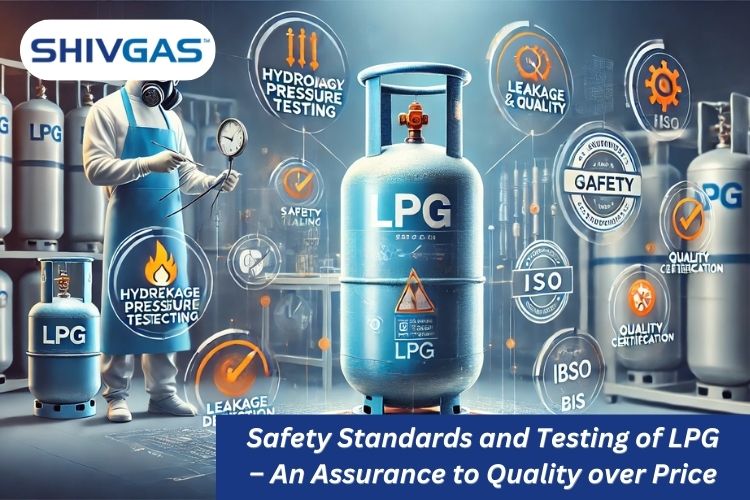
LPG gas, though known to be remarkably flammable, should be handled with care. To this end, strict standards and trials are an essential part of the process. There is no harm when we think of manufacturing LPG Gas cylinders but it should be done in compliance with safety. Such cylinders are made under the supervision of International safety regulations such as ISO and national laws. This ensures that the perfect pressure level is met, screwing up the probability of leakage.
The production of LPG gas is done according to the Indian Standards, the Bureau of Indian Standards (BIS) checks each batch of LPG cylinders. It is noticed that most accidents from LPG gas cylinders occur because of small holes in the pipe connections, use of non-certified equipment, wear and tear in the hosepipe.
The safety measures of LPG adhere to the international and national regulations. ISO standards such as ISO 9001 and 4706 falling within the jurisdiction of a particular set of authorities guarantee the maximum level of safety supplied to LPG gas cylinders.
The materials for construction of the LPG gas cylinders should offer a high standard of quality, so that they can adequately endure corrosion, pressure, and violent shocks.
Leisure and business premises have not been in danger of receiving poor quality LPG gas, for during the manufacturing process rigid controls were implemented which include selective control over materials of fabrication. For the catering gas cylinders alone which require multiple tests such as hydrostatic pressure tests before being allowed into stores for sale.
LPG cylinders are subjected to a number of tests including the pressure test, leak detection test and visual scans to examine for possible defects. The regular inspection of the standards ensures these LPG gas cylinders pass the safety standards for the duration of their usefulness.
Start your journey with LPG dealership today!
Testing of LPG gas involves multiple stages that assure safety and integrity in terms of performance and supply.
After the cylinders are manufactured, they are hydrostatic pressure tested. In this process, the cylinder is filled with water and the pressure applied on it is much more than that which would occur during normal use. The intention behind this is to check if the cylinder can bear the LPG gas it will contain or not. If there is deformation, leakage, or failure at this stage, then it indicates a flaw in the cylinder's construction.
Leak tests are done to ensure the cylinder's sealing and valve mechanisms. In this step, the cylinder is pressurized with gas, and seams, valves, and connections are inspected carefully for leaks. One of the common methods applied is the bubble test, in which soapy water is applied to all potential leak points. Any bubbling is considered a leak that must be attended to before the cylinder can be deemed safe for use.
When the cylinder clears these preliminary tests, it goes for final post-production inspection where all the required safety valves, regulators and fittings are mounted onto the cylinder and operational. These are of great importance in ensuring that the cylinder is operated safely.
Periodic requalification tests are critical after the cylinder is in service. This comprises pressure tests and visual inspections to ensure that, over time, the cylinder will continue to be safe and show no signs of wear or damage that could affect its performance. Routine maintenance checks help prevent leaks and identify potential problems before they become serious safety issues.
To ensure ultimate safety in respect of your home or commercial business, some things must be kept in consideration to avoid mishaps that would otherwise be unnecessary.
Inspect for dents, cracks, or corrosion on the cylinder. All the visible damage on the cylinder weakens it and therefore increases the possibilities of leaks and ruptures that make it unfit for use.
Also, ensure that the valve and the regulator of the cylinder are in proper working condition. It should not have resistance in opening and closing, and the regulator should not leak. Leaks in faulty valves or regulators can lead to gas leaks, which are dangerous.
This is achieved by applying soapy water on the valve and joints. When there are some bubbles, it means it leaks, and thus the cylinder may require either repairing or replacing. Any small leakage might lead to hazardous conditions.
LPG cylinders have limited lifespans and need periodical requalification. Check for the expiry date at the cylinder and confirm that it has undergone necessary pressure tests. There is a huge risk associated with using an expired or unqualified cylinder.
SHIVGAS is committed to providing the safest LPG cylinders, following the strict industry standards and safety protocols. Each cylinder undergoes rigorous testing, including pressure and leak tests, to ensure reliability and durability. SHIVGAS cylinders are made from high-quality materials that are resistant to corrosion and damage, ensuring long-lasting performance. Focusing on safety, we ensure that every cylinder meets the highest quality assurance, giving customers peace of mind and secure LPG usage.
The basis of ensuring excellence and safety in LPG cylinders comes through strict safety standards and strong testing. It may ensure, through international regulation as well as intense inspection procedures, that all cylinders pass the strictest safety and performance measures. Material inspection, pressure testing, leakage detection, and maintenance, for instance, are the steps in the whole procedure, reducing the chances of accidents and making the LPG system more reliable. This would ensure LPG is secure and efficient, yet remains a consumer-friendly energy source to support long-term sustainability in the industry.
Comment (0)